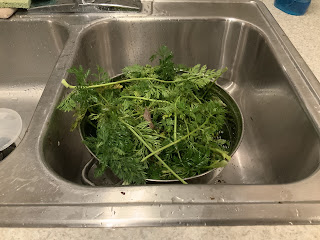A blizzard was predicted for Christmas Day.
Despite the threatening weather forecast, John and I left Berryridge
Farm a few days before Christmas for a very different kind of holiday—an urgent
family matter. Since we moved out here, we had never
traveled over the holidays, due to weather issues. Besides, we loved our own
little holiday traditions, and were happy to see family a few days before or
after Christmas.
But this year, leaving wasn’t optional. We set out in a rush, with our
concerns for our place on the back burner—far too stressed out to adequately prepare
for bad weather here at home.
While we were away, I checked our local forecast—and it was more dire
than the original. Nighttime temps way down in the single-digits, which we
rarely get in the Foothills. But here we were, far from home, and there was
nothing we could do about looking after our place.
We’d planned to return the day after Christmas, driving all evening…but
poor road conditions told us it would be far wiser to wait until daylight. So
after delaying our trip, we set out the next morning for 300 mile drive home,
often forced to crawl along on the snow and ice covered highways.
As we got closer to home, long after dark, John had to punch through
snowdrifts covering the narrow county road. Our private lane was passable, but in
places, just barely. When John finally pushed through more drifts at the top of
our driveway, we breathed a sigh of relief.
We had a over a foot of snow to shovel away from the door to get inside. I
kicked off my shoes and went straight to the kitchen faucet and turned it on.
Nothing.
Our pipes were frozen.
We had followed the perfect recipe for a frozen water system. Before we
left:
We did NOT block the crawlspace vents, which we always do around
Thanksgiving. The frigid Christmas Northeaster was thus totally free to wreak
havoc on the pipes under the house.
We did NOT turn on the pumphouse heater to keep the pipes from freezing
out there. This is a no brainer, since we generally do this whenever the temps
go below 20 degrees.
Lastly, we did NOT leave any faucets dripping in the house.
The next day after our return, in a rush to thaw the pumphouse pipes, I managed to blow the frost plug out of the water meter. Water spewed out, whooshing dangerously close to our new battery system for our backup solar well-pump.
I atoned for my
boo-boo by chopping wood while John sought advice from our neighbors. And after he lined up a plumber, $200 later the pumphouse was back on line. But still no running water in
the house.
Clearly, underneath the house, everything was frozen solid. After 15 years in the Foothills, it was a first.
So. Rationing drinking water, and little to spare for toothbrushing. No showers, not even face washing. Dirty dishes piling up in the sink (Very hard for this tidy person). Absolutely no post-Christmas baking and cooking I hadn’t had time for before the holiday.
And let me tell you, hauling water 180 feet from the
pumphouse to flush toilets loses its charm very fast.
 |
| Hens pecking for scratch in the cold |
Our wonderful neighbors who gifted us with our chickens, were the ones to save our
bacon. This afternoon, they loaned us a space heater. John got on his grubbiest gear, and with a series of
pretzel contortions, managed to crawl down, snake around the ductwork and
piping, and place the heater as near the water pipes as he could and plug it
in.
All we had to do was be patient. Just to make sure we didn’t get too overconfident, John hauled in two more buckets of water for the toilets.
 |
| Crawlspace entry…for man 5’11 and 200 + lbs! |
I watched the faucets like a hawk, ears strained for the tiniest drip.
Then, four hours later….Eureka! Dripping faucets!
We’d had no running water for 72 hours…and since the pipes very likely froze Christmas Day, our whole water system had been frozen for 5 full days. Another first.
It took about 20 or 30 minutes for the pipes to completely open and
full pressure to return—lots of sediment to flush out as well. But Berryridge
Farm is back in business. Showers, dishes, cooking, the sky’s the limit!
This was a hard lesson, that we won’t soon forget. So one more time:Northeaster Deep Freeze, 3-step
preparedness:
Block crawlspace vents.
Turn on pumphouse heater.
Leave faucets dripping.
We already knew there’s no place like home for Christmas—and we plan to
be here next time around!






























